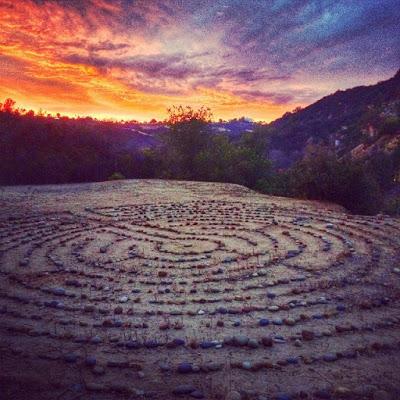Walking Maze by Heidi Santschi of Heidi Santschi Garden Design
Most of us have encountered the chakras at some point in our yoga journey. Some of us have solid knowledge of the origins and meanings. And many of us may be wondering if the chakras have relevance to our yoga practice and the issues we deal with every day.My answer to that wondering is an unequivocal yes! Over my next several posts I’ll share what I’ve learned about the chakras as a useful model, or lens, through which to view ourselves and our lives. I’ve chosen the contemporary view because this is when and where we exist. Even so, it is important to understand the history of the chakras because history provides context, and context gives us a foundation on which to build a contemporary view that supports the yoga tools we use to work with the chakras. Reading Nina’s post Friday Q&A: Chakras That Are True to Yoga is a great first step. The next step is learning how to view the chakras as a useful model for healthy aging. We know we have a physical body (anamayakosha) because our five senses tell us that we are solid flesh and blood. We also have an energy body (pranamayakosha), which includes the nadis, pranavayus, auras and chakras. This can be harder to grasp because our energy anatomy is not physical. But while it is not solid flesh and blood, it does intersect with and impact our physical body and the mental, emotional and spiritual aspects that exist within it. Therefore, our mission, if we choose to accept it, is to deepen our understanding of the relationship between the physical and energetic systems (which are actually one in the same but we don’t need to get too wonky here) to inform, enhance and deepen our life experience and our yoga practice.Are these chakras real? There is no hard scientific evidence. A pathologist can perform an autopsy to locate and dissect all of our physical parts but will not find or be able to dissect the chakras. Acceptance of the chakras will depend on your openness to the reality and relevance of a philosophical and psychological model that you cannot see, touch, smell, hear ,or taste (well, some people claim to be able to ‘see’ chakras but that’s subject for someone else to tackle). Christopher Wallis, PhD, in his article The Real Truth About the Chakras, writes that many different chakra systems come down to us from the texts of Tantra yoga:“five-chakra systems, six-chakra systems, seven, nine, ten, fifteen, twenty-one, twenty-eight and more chakras are taught, depending on what text you’re looking at.” For the purpose of this series, I’ll be referring to the system that describes seven energy centers located at different points in the body along the spinal column. These chakras and their locations are said to be:
- Muladhara (root chakra – between the perineum and the pelvic bone)
- Svadhisthana (sacral chakra - 4 fingers width below navel)
- Manipura (solar plexus chakra – in the abdomen above the navel)
- Anahata (heart chakra – center of the chest)
- Vishuddha (throat chakra – neck/throat)
- Ajna (third eye chakra – centered between the eyebrows)
- Sahasrara (crown chakra – top of the head)
- Yamas and niyamas (ethics and actions)
- Asana
- Pranayama
- Guided imagery
- Mudra
- Meditation
- Chanting and affirmations
Subscribe to Yoga for Healthy Aging by Email ° Follow Yoga for Healthy Aging on Facebook and Twitter ° To order Yoga for Healthy Aging: A Guide to Lifelong Well-Being, go to Amazon, Shambhala, Indie Bound or your local bookstore.
For information on Beth Gibbs' classes and upcoming workshops, see Beth's Classes and Workshops and for information about Beth, ProYoga Therapeutics, and Beth's book and CD, see proyogatherapeutics.com.

